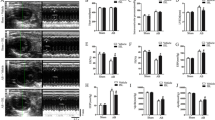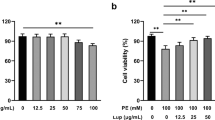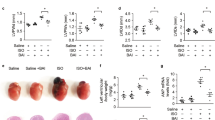Abstract
Cardiac hypertrophy is a compensatory response in reaction to mechanical load that reduces wall stress by increasing wall thickness. Chronic hypertrophic remodeling involves cardiac dysfunction that will lead to heart failure and ultimately death. Studies have been carried out on cardiac hypertrophy for years, whereas the mechanisms have not been well defined. Tamarixetin (TAM), a natural flavonoid derivative of quercetin, have been demonstrated possessing anti-oxidative and anti-inflammatory effects on multiple diseases. However, little is known about the function of TAM on the development of cardiac hypertrophy. Here, we found TAM could alleviate pressure-overload-induced cardiac hypertrophy in transverse aortic constriction (TAC) mouse model, assessed by ventricular weight/body weight, lung weight/body weight, echocardiographic parameters, as well as myocyte cross-sectional area and the expression of ANP, BNP and Myh7. In vitro, TAM showed a dose dependent inhibitory effect on phenylephrine-induced hypertrophy in H9c2 cardiomyocytes. Furthermore, TAM reversed cardiac remodeling of stress overloaded heart by suppressing apoptosis and the expression of fibrotic-related genes, reduced oxidative stress and ROS production both in vivo and in vitro. In addition, TAM could negatively modulate TAC-induced nuclear translocation of NFAT and the activation of PI3K/AKT signaling pathways. Therefore, these data indicate for the first time that TAM has a protective effect on experimental cardiac hypertrophy and might be a novel candidate for the treatment of cardiac hypertrophy in clinic.






Similar content being viewed by others
References
Aoyagi T, Matsui T (2011) Phosphoinositide-3 kinase signaling in cardiac hypertrophy and heart failure. Curr Pharm Des 17:1818–1824
Benard L, Oh JG, Cacheux M, Lee A, Nonnenmacher M, Matasic DS, Kohlbrenner E, Kho C, Pavoine C, Hajjar RJ, Hulot JS (2016) Cardiac Stim1 silencing impairs adaptive hypertrophy and promotes heart failure through inactivation of mTORC2/Akt signaling. Circulation 133:1458–1471
Chen L, Liu P, Feng X, Ma C (2017) Salidroside suppressing LPS-induced myocardial injury by inhibiting ROS-mediated PI3K/Akt/mTOR pathway in vitro and in vivo. J Cell Mol Med 21:3178–3189
Clemente CF, Xavier-Neto J, Dalla Costa AP, Consonni SR, Antunes JE, Rocco SA, Pereira MB, Judice CC, Strauss B, Joazeiro PP, Matos-Souza JR, Franchini KG (2012) Focal adhesion kinase governs cardiac concentric hypertrophic growth by activating the AKT and mTOR pathways. J Mol Cell Cardiol 52:493–501
Cui S, Cui Y, Li Y, Zhang Y, Wang H, Qin W, Chen X, Ding S, Wu D, Guo H (2018) Inhibition of cardiac hypertrophy by aromadendrin through down-regulating NFAT and MAPKs pathways. Biochem Biophys Res Commun 506:805–811
Dorn GW 2nd, Force T (2005) Protein kinase cascades in the regulation of cardiac hypertrophy. J Clin Investig 115:527–537
Duran J, Oyarce C, Pavez M, Valladares D, Basualto-Alarcon C, Lagos D, Barrientos G, Troncoso MF, Ibarra C, Estrada M (2016) GSK-3beta/NFAT signaling is involved in testosterone-induced cardiac myocyte hypertrophy. PLoS ONE 11:e0168255
Fischer TH, Herting J, Tirilomis T, Renner A, Neef S, Toischer K, Ellenberger D, Forster A, Schmitto JD, Gummert J, Schondube FA, Hasenfuss G, Maier LS, Sossalla S (2013) Ca2+/calmodulin-dependent protein kinase II and protein kinase A differentially regulate sarcoplasmic reticulum Ca2+ leak in human cardiac pathology. Circulation 128:970–981
Gao L, Yao R, Liu Y, Wang Z, Huang Z, Du B, Zhang D, Wu L, Xiao L, Zhang Y (2017) Isorhamnetin protects against cardiac hypertrophy through blocking PI3K-AKT pathway. Mol Cell Biochem 429:167–177
Guo H, Zhang X, Cui Y, Zhou H, Xu D, Shan T, Zhang F, Guo Y, Chen Y, Wu D (2015) Taxifolin protects against cardiac hypertrophy and fibrosis during biomechanical stress of pressure overload. Toxicol Appl Pharmacol 287:168–177
Hardt SE, Sadoshima J (2002) Glycogen synthase kinase-3beta: a novel regulator of cardiac hypertrophy and development. Circ Res 90:1055–1063
Hayamizu K, Morimoto S, Nonaka M, Hoka S, Sasaguri T (2018) Cardiotonic actions of quercetin and its metabolite tamarixetin through a digitalis-like enhancement of Ca2+ transients. Arch Biochem Biophys 637:40–47
Hutchings DC, Anderson SG, Caldwell JL, Trafford AW (2018) Phosphodiesterase-5 inhibitors and the heart: compound cardioprotection? Heart 104:1244–1250
Li M, He HP, Gong HQ, Zhang J, Ma WJ, Zhou H, Cao DS, Wang N, Zhang TC (2016) NFATc4 and myocardin synergistically up-regulate the expression of LTCC alpha1C in ET-1-induced cardiomyocyte hypertrophy. Life Sci 155:11–20
Li Y, Xia J, Jiang N, Xian Y, Ju H, Wei Y, Zhang X (2018) Corin protects H2O2-induced apoptosis through PI3K/AKT and NF-kappaB pathway in cardiomyocytes. Biomed Pharmacother 97:594–599
Liu C, Cao F, Tang QZ, Yan L, Dong YG, Zhu LH, Wang L, Bian ZY, Li H (2010) Allicin protects against cardiac hypertrophy and fibrosis via attenuating reactive oxygen species-dependent signaling pathways. J Nutr Biochem 21:1238–1250
Maulik SK, Kumar S (2012) Oxidative stress and cardiac hypertrophy: a review. Toxicol Mech Methods 22:359–366
Molkentin JD (2004) Calcineurin-NFAT signaling regulates the cardiac hypertrophic response in coordination with the MAPKs. Cardiovasc Res 63:467–475
Nakamura K, Murakami M, Miura D, Yunoki K, Enko K, Tanaka M, Saito Y, Nishii N, Miyoshi T, Yoshida M, Oe H, Toh N, Nagase S, Kohno K, Morita H, Matsubara H, Kusano KF, Ohe T, Ito H (2011) Beta-blockers and oxidative stress in patients with heart failure. Pharmaceuticals (Basel) 4:1088–1100
Park HJ, Lee SJ, Cho J, Gharbi A, Han HD, Kang TH, Kim Y, Lee Y, Park WS, Jung ID, Park YM (2018) Tamarixetin exhibits anti-inflammatory activity and prevents bacterial sepsis by increasing IL-10 production. J Nat Prod 81:1435–1443
Perrelli MG, Tullio F, Angotti C, Cerra MC, Angelone T, Tota B, Alloatti G, Penna C, Pagliaro P (2013) Catestatin reduces myocardial ischaemia/reperfusion injury: involvement of PI3K/Akt, PKCs, mitochondrial KATP channels and ROS signalling. Pflugers Arch 465:1031–1040
Rai V, Sharma P, Agrawal S, Agrawal DK (2017) Relevance of mouse models of cardiac fibrosis and hypertrophy in cardiac research. Mol Cell Biochem 424:123–145
Rothermel BA, McKinsey TA, Vega RB, Nicol RL, Mammen P, Yang J, Antos CL, Shelton JM, Bassel-Duby R, Olson EN, Williams RS (2001) Myocyte-enriched calcineurin-interacting protein, MCIP1, inhibits cardiac hypertrophy in vivo. Proc Natl Acad Sci USA 98:3328–3333
Samak M, Fatullayev J, Sabashnikov A, Zeriouh M, Schmack B, Farag M, Popov AF, Dohmen PM, Choi YH, Wahlers T, Weymann A (2016) Cardiac hypertrophy: an introduction to molecular and cellular basis. Med Sci Monit Basic Res 22:75–79
Schulz RA, Yutzey KE (2004) Calcineurin signaling and NFAT activation in cardiovascular and skeletal muscle development. Dev Biol 266:1–16
Shimizu I, Minamino T (2016) Physiological and pathological cardiac hypertrophy. J Mol Cell Cardiol 97:245–262
Toba H, Cannon PL, Yabluchanskiy A, Iyer RP, D’Armiento J, Lindsey ML (2017) Transgenic overexpression of macrophage matrix metalloproteinase-9 exacerbates age-related cardiac hypertrophy, vessel rarefaction, inflammation, and fibrosis. Am J Physiol Heart Circ Physiol 312:H375–H383
Van Rooij E, Doevendans PA, Crijns HJ, Heeneman S, Lips DJ, van Bilsen M, Williams RS, Olson EN, Bassel-Duby R, Rothermel BA, De Windt LJ (2004) MCIP1 overexpression suppresses left ventricular remodeling and sustains cardiac function after myocardial infarction. Circ Res 94:e18–e26
Weeks KL, Bernardo BC, Ooi JYY, Patterson NL, McMullen JR (2017) The IGF1-PI3K-Akt signaling pathway in mediating exercise-induced cardiac hypertrophy and protection. Adv Exp Med Biol 1000:187–210
Whayne TF Jr (2018) Clinical use of digitalis: a state of the art review. Am J Cardiovasc Drugs 18:427–440
Xu L, Brink M (2016) mTOR, cardiomyocytes and inflammation in cardiac hypertrophy. Biochim Biophys Acta 1863:1894–1903
Yadav DK, Bharitkar YP, Hazra A, Pal U, Verma S, Jana S, Singh UP, Maiti NC, Mondal NB, Swarnakar S (2017) Tamarixetin 3-O-beta-d-glucopyranoside from Azadirachta indica leaves: gastroprotective role through inhibition of matrix metalloproteinase-9 activity in mice. J Nat Prod 80:1347–1353
Zhang Y, Cui Y, Deng W, Wang H, Qin W, Huang C, Li C, Zhang J, Guo Y, Wu D, Guo H (2017) Isoquercitrin protects against pulmonary hypertension via inhibiting PASMCs proliferation. Clin Exp Pharmacol Physiol 44:362–370
Acknowledgements
This study was supported by grants from the National Natural Science Foundation of China (Grant Nos. 81300162; 81300459), Natural Science Foundation of Shandong Province (Grant No. ZR2016HM48) and Natural Science Foundation of Hubei Province (Grant No. 2017CFB170). Project funded by China Postdoctoral Science Foundation (Grant Nos. 2014M551921; 2017M610429; 2018T110694) and the International Postdoctoral Exchange Fellowship Program.
Author information
Authors and Affiliations
Corresponding authors
Ethics declarations
Conflict of interest
The authors declare that there are no conflicts of interest.
Additional information
Publisher's Note
Springer Nature remains neutral with regard to jurisdictional claims in published maps and institutional affiliations.
Electronic supplementary material
Below is the link to the electronic supplementary material.
Rights and permissions
About this article
Cite this article
Fan, C., Li, Y., Yang, H. et al. Tamarixetin protects against cardiac hypertrophy via inhibiting NFAT and AKT pathway. J Mol Hist 50, 343–354 (2019). https://doi.org/10.1007/s10735-019-09831-1
Received:
Accepted:
Published:
Issue Date:
DOI: https://doi.org/10.1007/s10735-019-09831-1




